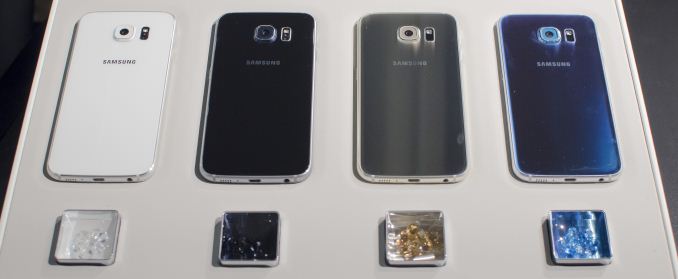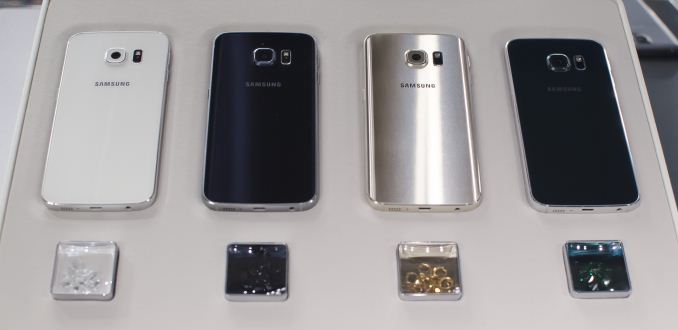Samsung Galaxy S 6 and S 6 Edge: Preview
by Joshua Ho on March 26, 2015 9:00 AM EST- Posted in
- Smartphones
- Samsung
- Mobile
- Galaxy S6
- Galaxy S6 Edge
Initial Thoughts
With the Galaxy S6 and S6 edge Samsung claimed that they wanted to completely rethink how they designed and made smartphones. On the surface, it seems that Samsung has delivered on this promise as the Galaxy S6 and S6 edge are unlikely any other Galaxy S phone they have made previously. There is no removable battery, no microSD slot, or even a removable back cover. I would’ve liked to see a microSD slot, but I personally wouldn’t be affected by being limited to 32GB of internal storage. The removable battery issue is a bit concerning for me though, as it’s likely that disassembling this phone to replace the battery will require extensive use of a heat gun to loosen glue that may not adhere properly when reassembled. The materials are now aluminum and glass, which dramatically affect in-hand feel. I definitely like the move to the aluminum and glass design for the improved look and feel of the phone, but the use of the glass back is a bit annoying as the phones have a tendency to slide off pretty much any table. The edge variant of the phone also feels quite sharp in the hand and almost too thin to hold, but this is generally quite subjective.
Outside of design, there is a lot to talk about in the SoC and display. The Exynos 7420 SoC appears to be class-leading in performance, although there is the obvious question of power consumption that still has to be answered. Samsung’s first 14LPE SoC seems promising, although we’ve yet to validate whether big.LITTLE is more efficient than when we last tested it in the Exynos 5433. The GPU is generally quite close to the Adreno 430, with about a 10-20% advantage in performance depending upon the workload, although at the same clock speed it probably wouldn’t have any advantage. The 1440p display can also reduce performance compared to a 1080p display.
Speaking of displays, Samsung has integrated an incredible display into both versions of the Galaxy S6. I’m really blown away at how far AMOLED has come in the past few years, as the Galaxy S6 is one of the best displays we’ve tested for luminance and overall color accuracy. The only real problems I can see are color shifts with viewing angles, and white point tending to be a bit green depending upon the unit we’re looking at. There are some edge-specific issues, namely uneven luminance and odd color shifting towards green hues on white at the edge of the display. Other than this, the display of the Galaxy S6 is relatively perfect with its dark, inky blacks and amazing color.
Obviously an SoC and display aren’t the only issues to discuss in a smartphone, but given the limited time that we’ve had with the device this was all that could be tested. We hope to have our full review for both devices completed in the near future, and to be able to provide the full picture of the Galaxy S6 line at that time. Pre-orders for the US Galaxy S6 variants will begin on March 27th, and the phone will go on sale on April 10th throughout the US with 32, 64, and 128 GB SKUs in Black Sapphire, White Pearl, and Gold Platinum. The S6 edge and S6 will be available on AT&T, Sprint, T-Mobile, Verizon, and US Cellular, but on Boost Mobile, Cricket Wireless, and MetroPCS only the S6 will be available.













200 Comments
View All Comments
mkozakewich - Thursday, March 26, 2015 - link
For most things, like games, they'll be running on a reduced resolution. You can expect high performance, then.makxon - Friday, March 27, 2015 - link
this! ya, a lot people just don't understandmelgross - Thursday, March 26, 2015 - link
A major problem with OLEDs which wasn't mentioned in the article, is that because of brightness issues, and yes, this display has them as well, they need that Pentile array to raise the brightness. But the Pentile display lowers resolution by about 30%. So they then need to raise resolution to make up for it. So a 1440 display isn't much sharper, in real world use, than a 1080 display.As far as why they don't allow that super brightness in manual use is not just because of battery use, but because of display heat. If they allow that to be used all the time, the display life, which is directly dependent on the heat generated, will be considerably shortened. It's also likely that the different colors have differing maximum brightness levels, so it can't be balanced at that high a level.
This are problems OLED manufacturers have been having from the beginning.
I would say that this is one of the best smartphone displays out there, but not THE best.
makxon - Friday, March 27, 2015 - link
no need to get humble, super amoled is the best display on any smartphone period.superflex - Friday, March 27, 2015 - link
Paid shill warning.TrojMacReady - Friday, March 27, 2015 - link
Lots of assumptions. Yes, LED life shortens with higher temperatures, but we don't know the temperatures, nor the current life expectancy (which has improved several times over the past years). And even without auto boost, visibility is great, not in the least thanks to a relatively low reflectivity. *Without* the boost, it's still much easier to read in high ambient lighting than the HTC M9 and no worse than an iPhone 6 (Plus), if not slightly better.Meaning, auto boost is actually a bonus beyond that.
TrojMacReady - Friday, March 27, 2015 - link
The GPU performance is great (class leading for phones) if you set it to your desired resolution (balance quality vs framerates) for the applications used.mkozakewich - Thursday, March 26, 2015 - link
This just requires better customer support from Samsung. They need to replace batteries that have lost significant health in less than two years.The other thing would be to post reminders that reducing the battery below 20% can damage it (conservatively speaking, of course.) I'd like to see them shut down the phone at 10%.
jbm - Thursday, March 26, 2015 - link
Yes, especially since on my two Android phones so far (S4 / S4 mini), I had nothing but a horrible experience with battery life. By that, I mean that the battery life is WILDLY INCONSISTENT even when doing the EXACT SAME things. I do not use my phone much. I do not play games on it, I do not watch videos or listen to music. I just use it as a phone (not many calls per day, mainly SMS and checking of mails). I always have the "power saving" mode active. Still, when doing the exact same things (leaving for work at 7am, putting the phone on the desk at work, going home at 5pm), on one day the phone is still at 90% battery when I leave work (about 1% per hour), on the next day it is only at 60%. When I got my S4 mini, I tried out the battery life and got nearly 3 days out of it. Then I charged it up, and the next day it went from full to 40% in one day. How can this be possible? What madness is this? All I can guess it that some system processes just go bonkers at random (the main battery usage according to the list always is "phone in standby"). I got a second battery together with a separate battery charger, and one thing I noticed is that when I power off the phone in the morning, take out the battery and replace it with the charged one (as opposed to actually charging the phone itself via USB cable and leaving the battery in), I never get the "mega battery drain".Oh, and on the S4 which I had before the S4 mini, the battery went dead within one year (the phone would turn itself off within 1-2 minutes after powering on).
Well, now enter the S6 without a replaceable battery. No, thanks. No Samsung for me anymore, and also no Android by anybody else.
Darkito - Thursday, March 26, 2015 - link
If your phone is rooted, download the BetterBatteryStats app. Some process is causing a wakelock and most of the time you just need to get rid of some offending app. I had an app that simulated Moto's Active Display and it was destroying battery life and not showing up in the regular battery stats screen.